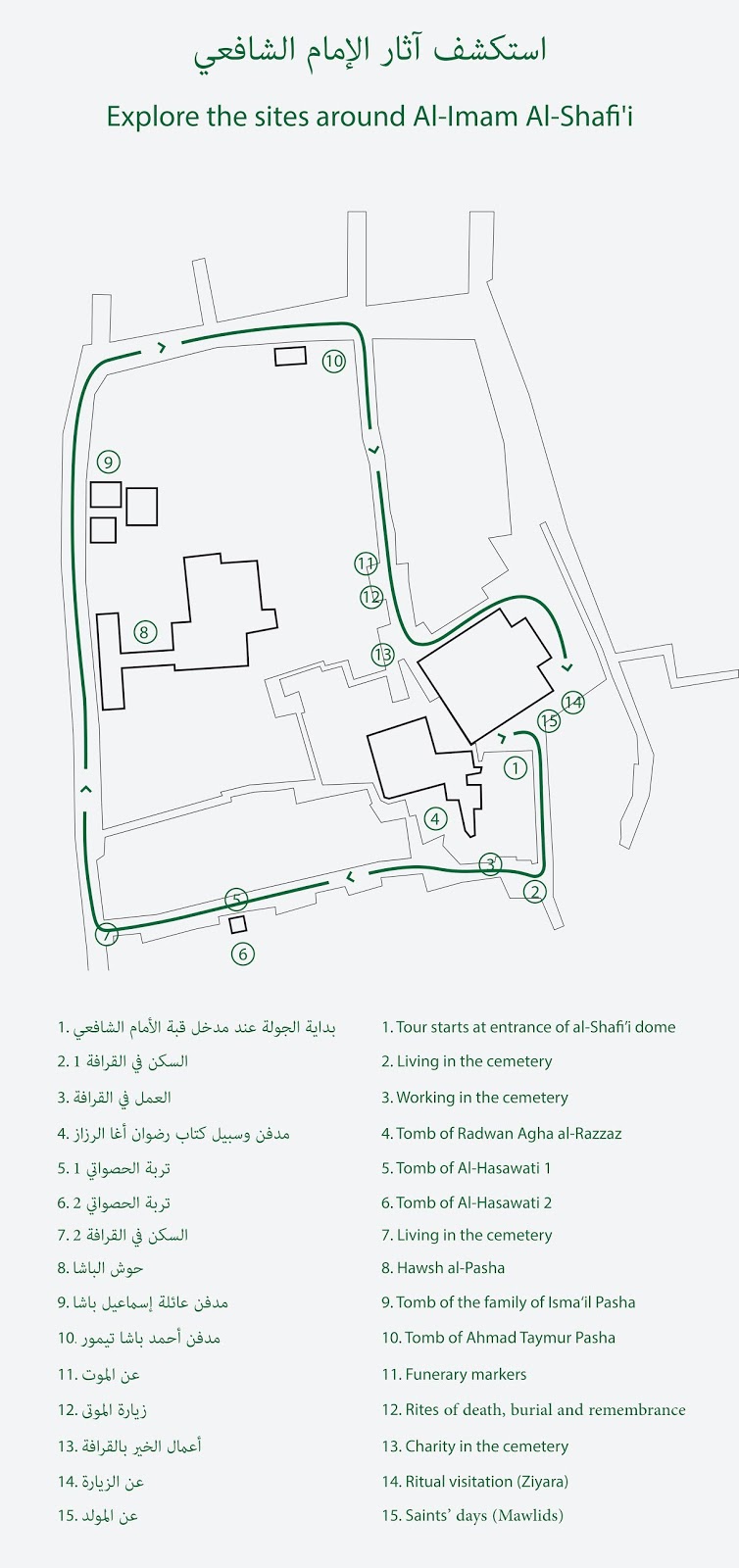المولد / Saints Days (Mawlids)
المولد مناسبة سنوية للاحتفاء بالولي أو الشخصية الدينية. وليس من الضرورة أن يأتي الاحتفال يوم ميلاد الولي فمولد الإمام الشافعي مثلًا يقام سنويًا بالأربعاء الأول من شعبان وليس في تاريخ بعينه.
أول تأريخ للموالد في مصر جاء في نهاية القرن السابع هـ | الثالث عشر م. لا نعرف بالضبط متى بدأ مولد الإمام الشافعي لكن يذكر الرحالة أوليا شلبي أن عدد الرواد في العصر العثماني كان حوالي عشرة آلاف. قد يكون التقدير به بعض المبالغة لكن لابد أن أحد أسباب إقبال الناس على هذا المولد بالذات هو الاعتقاد بأن أرواح جميع الأولياء الصالحين تكون متواجدة به. فكان الناس يؤجرون المنازل للمبيت بالمنطقة ولقضاء أكبر قدر من الوقت بالمولد وبالسوق المصاحب له والمقام على مدى ثلاثة أيام. وكان مولد الإمام الشافعي واحد من عشرين مولدًا يتم الاحتفال بهم بالقرافة بالقرن التاسع عشر. أما في ثلاثينات القرن العشرين فكان من أعظم موالد القاهرة لدرجة أن الحكومة كانت تنصب خيمة تشريفة كبيرة للمشاركة في الاحتفال.
أول تأريخ للموالد في مصر جاء في نهاية القرن السابع هـ | الثالث عشر م. لا نعرف بالضبط متى بدأ مولد الإمام الشافعي لكن يذكر الرحالة أوليا شلبي أن عدد الرواد في العصر العثماني كان حوالي عشرة آلاف. قد يكون التقدير به بعض المبالغة لكن لابد أن أحد أسباب إقبال الناس على هذا المولد بالذات هو الاعتقاد بأن أرواح جميع الأولياء الصالحين تكون متواجدة به. فكان الناس يؤجرون المنازل للمبيت بالمنطقة ولقضاء أكبر قدر من الوقت بالمولد وبالسوق المصاحب له والمقام على مدى ثلاثة أيام. وكان مولد الإمام الشافعي واحد من عشرين مولدًا يتم الاحتفال بهم بالقرافة بالقرن التاسع عشر. أما في ثلاثينات القرن العشرين فكان من أعظم موالد القاهرة لدرجة أن الحكومة كانت تنصب خيمة تشريفة كبيرة للمشاركة في الاحتفال.
ومن الطقوس الاحتفالية بمولد الإمام الشافعي بالقرن الثامن عشر والتاسع عشر
الذكر - أي حلقة لذكر الله بصفة بجماعية
الدوسة – حيث يركب شيخ الطريقة حصانه فوق أجساد المريدين الملقاة على الأرض ويعد دليلًا على قدرة المتصوف على الارتقاء فوق الآلام الجسدية
الكنسة – حيث يقوم الزائر بكنس أرضية ضريح الإمام الشافعي والاحتفاظ بما تم كنسه للتبرك به
ومن الطقوس الباقية ليومنا هذا ملئ العشاري أعلى القبة بالبذور لإطعام الطيور وكتابة الجوابات للإمام الشافعي وتركها داخل المقصورة
 |
للدخول الي اللعبة أضغط هنا |
Mawlids are recorded to have started in Egypt around the end of the 13th century. We do not know exactly when the celebration of Mawlid al-Imam al-Shafi’i started, but the traveller Evliya Çelebi estimated 10,000 participants in the mawlid he attended here in the Ottoman period. The number may be exaggerated, but the belief that it was visited by the spirits of all the walis must have made it popular. People rented houses there to spend as much time possible and attend the three-day market. Mawlid al-Shafi’i was one of 20 mawlids held in the cemetery in 19th century. In the 1930s, it was one of the grandest in the city, even celebrated by the government, who set up an official tent (tashrifa).
Mawlid rituals practiced in al-Shafi’i in the 18th and 19th centuries include:
Dhikr: the group repetition of the name of God or of a certain religious formula as a means of contemplating God.
Dawsa: a street spectacle in which the followers of a sufi order lay on the ground and their sheikh rides on horseback over their bodies without harming them.
Kansa; where the floor of the Shafi’i shrine is swept and bits of thread or carpet from the sweepings kept for baraka.
Modern rituals include the annual ceremony to fill the dome’s boat-like finial with wheat for birds and writing letters to al-Imam al-Shafi’i to ask for his succour with personal problems or to confess certain sins.
Dhikr: the group repetition of the name of God or of a certain religious formula as a means of contemplating God.
Dawsa: a street spectacle in which the followers of a sufi order lay on the ground and their sheikh rides on horseback over their bodies without harming them.
Kansa; where the floor of the Shafi’i shrine is swept and bits of thread or carpet from the sweepings kept for baraka.
Modern rituals include the annual ceremony to fill the dome’s boat-like finial with wheat for birds and writing letters to al-Imam al-Shafi’i to ask for his succour with personal problems or to confess certain sins.
